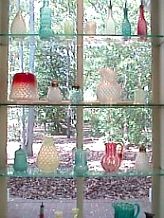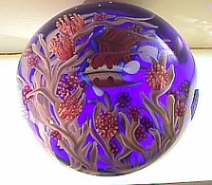Wheaton
Village
1501
Glasstown Rd.
Millville,
NJ. 08332
October 12, 2001
As usual  when we
travel, anytime we find a listing for a living history museum we
try and include it on our itinerary. Such was the case with
Wheaton Village. Although, Wheaton Village was a little different
from most of the living history museums that we have gone to.
Usually the museums we go to showcase a particular period in
time. Then everyone in the village follows that theme. Wheaton
Village is centered on the T.C. Wheaton Glass Factory. This is a
working glass factory. You can go into the factory and watch the
glass making progress from the very beginning to the lovely
finished products which are for sale. They also have a program
where you can make your own paperweight. After
when we
travel, anytime we find a listing for a living history museum we
try and include it on our itinerary. Such was the case with
Wheaton Village. Although, Wheaton Village was a little different
from most of the living history museums that we have gone to.
Usually the museums we go to showcase a particular period in
time. Then everyone in the village follows that theme. Wheaton
Village is centered on the T.C. Wheaton Glass Factory. This is a
working glass factory. You can go into the factory and watch the
glass making progress from the very beginning to the lovely
finished products which are for sale. They also have a program
where you can make your own paperweight. After  watching
the glass making you absolutely have to go into the museum of
American Glass and see the hundreds of pieces of glass that they
have on exhibit. I think you get a much better feeling for the
finished glass pieces once you see the effort that goes into
creating them. I have seen glass museums before but this is by
far one of the best. This museum houses the finest, and largest,
collection of American glass in the country. Beyond the gleam of
the elegant lobby, the story of glass unfolds. As you walk
through the spacious halls and sunlit galleries, the thousands of
colors and shapes create a panorama of American glassmaking. The
comprehensive collection of over 6,500 objects range from Early
American bottles and flasks, Mason jars, and paperweights to
Tiffany masterpieces and the world's largest bottle. Each room is
a different
watching
the glass making you absolutely have to go into the museum of
American Glass and see the hundreds of pieces of glass that they
have on exhibit. I think you get a much better feeling for the
finished glass pieces once you see the effort that goes into
creating them. I have seen glass museums before but this is by
far one of the best. This museum houses the finest, and largest,
collection of American glass in the country. Beyond the gleam of
the elegant lobby, the story of glass unfolds. As you walk
through the spacious halls and sunlit galleries, the thousands of
colors and shapes create a panorama of American glassmaking. The
comprehensive collection of over 6,500 objects range from Early
American bottles and flasks, Mason jars, and paperweights to
Tiffany masterpieces and the world's largest bottle. Each room is
a different  chapter in the saga, with changing architecture
providing an interplay of elegance and simplicity. We found out
that the first attempt at glassmaking in the New World was in
Jamestown, Virginia, in 1608. Three later ventures were tried in
New York, Philadelphia and Salem, Massachusetts. It wasn't until
1739 that the first successful glass factory was established by
Caspar Wistar in Alloway, New Jersey. The Wistar factory operated
until 1777. Wistar defied English policy forbidding all
manufacturing in the Colonies. America was to supply raw
materials for England and furnish a market for English goods.
After the Revolution, the number of
chapter in the saga, with changing architecture
providing an interplay of elegance and simplicity. We found out
that the first attempt at glassmaking in the New World was in
Jamestown, Virginia, in 1608. Three later ventures were tried in
New York, Philadelphia and Salem, Massachusetts. It wasn't until
1739 that the first successful glass factory was established by
Caspar Wistar in Alloway, New Jersey. The Wistar factory operated
until 1777. Wistar defied English policy forbidding all
manufacturing in the Colonies. America was to supply raw
materials for England and furnish a market for English goods.
After the Revolution, the number of  glass factories steadily increased, meeting the
needs of the new nation. The Wheaton Village was very well laid
out on a beautifully landscaped site. Besides the museum and the
glass factory they have several other buildings. One of the
buildings is the crafts and trades row. It includes several
working artists creating individual works in such mediums as
pottery, woodcarving and, of course, glass. There is also the
Down Jersey folklife center. As New Jersey's first regional
folklife center they display examples of artistic and cultural
traditions maintained by residents of the state's eight southern
counties. You'll learn how diverse ethnic, regional, and occupational groups make up the living culture of "Down
Jersey." Discover traditions ranging from lifeguard shore
boat races and split-oak basket making, to the delicate art of
"origami." In addition to these buildings there are
various stores including
glass factories steadily increased, meeting the
needs of the new nation. The Wheaton Village was very well laid
out on a beautifully landscaped site. Besides the museum and the
glass factory they have several other buildings. One of the
buildings is the crafts and trades row. It includes several
working artists creating individual works in such mediums as
pottery, woodcarving and, of course, glass. There is also the
Down Jersey folklife center. As New Jersey's first regional
folklife center they display examples of artistic and cultural
traditions maintained by residents of the state's eight southern
counties. You'll learn how diverse ethnic, regional, and occupational groups make up the living culture of "Down
Jersey." Discover traditions ranging from lifeguard shore
boat races and split-oak basket making, to the delicate art of
"origami." In addition to these buildings there are
various stores including the Gallery of American Craft which includes
American crafts and one-of-a-kind contemporary works in all media
including pottery and glass items, by the Village artists.
There's also an old fashioned general store and a brownstone
emporium. Then you can always stop by the Christmas Shop where
they feature lovely hand blown glass ornaments and icicles. In
their Arthur Gorham paperweight shop they feature one of the
largest selections of traditional and contemporary paperweights
in the world. Other buildings include a stained glass studio, and
a Centre Grove Schoolhouse from 1876. You can board the
half-scale model of the 1863 C.P. Huntington Train at the
restored 1897 Palermo Train Station. Whether or not you have a
strong interest in glass, it is a lovely place to spend a day
just watching the artists at work.
the Gallery of American Craft which includes
American crafts and one-of-a-kind contemporary works in all media
including pottery and glass items, by the Village artists.
There's also an old fashioned general store and a brownstone
emporium. Then you can always stop by the Christmas Shop where
they feature lovely hand blown glass ornaments and icicles. In
their Arthur Gorham paperweight shop they feature one of the
largest selections of traditional and contemporary paperweights
in the world. Other buildings include a stained glass studio, and
a Centre Grove Schoolhouse from 1876. You can board the
half-scale model of the 1863 C.P. Huntington Train at the
restored 1897 Palermo Train Station. Whether or not you have a
strong interest in glass, it is a lovely place to spend a day
just watching the artists at work.
If you want to learn more just log onto their website at: http://www.wheatonvillage.org.
Good Luck! Have Fun! and Stay Safe!
Laura